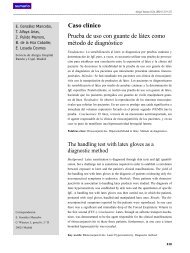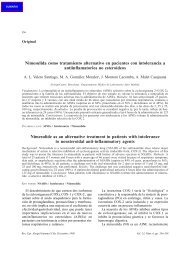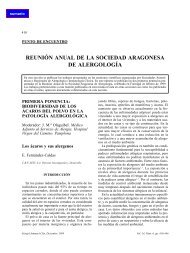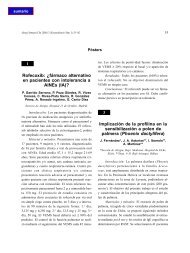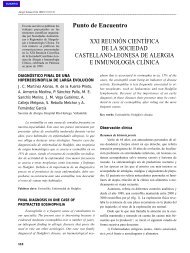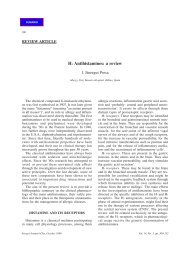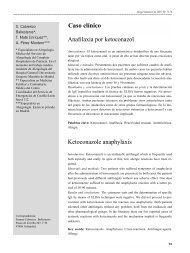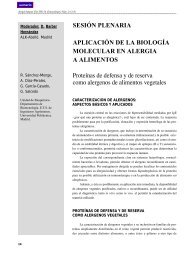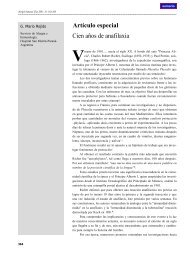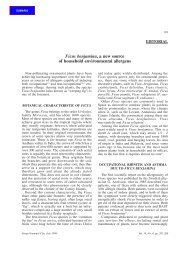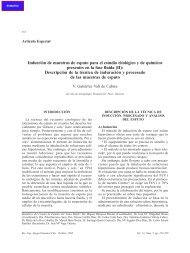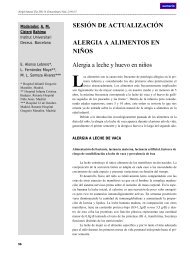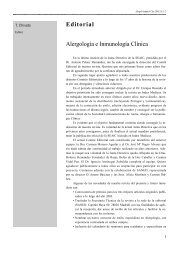Drug hypersensitivity: questionnaire Special article
Drug hypersensitivity: questionnaire Special article
Drug hypersensitivity: questionnaire Special article
You also want an ePaper? Increase the reach of your titles
YUMPU automatically turns print PDFs into web optimized ePapers that Google loves.
Alergol Inmunol Clin 2001;16: 48-53<br />
ENDA (European<br />
Network on <strong>Drug</strong><br />
Allergy)<br />
Initially translated into Spanish<br />
by the <strong>Drug</strong> Allergy<br />
Committee of the Spanish<br />
Society of Allergology and<br />
Clinical Immunology<br />
48<br />
<strong>Special</strong> <strong>article</strong><br />
<strong>Drug</strong> <strong>hypersensitivity</strong>: <strong>questionnaire</strong><br />
En daily clinical practise the assessment of drug <strong>hypersensitivity</strong> reactions<br />
is, with exceptions few and far between, both difficult and complex.<br />
There is however an almost unanimous agreement in that far less<br />
such reactions are detected and diagnosed than the number that actually occurs.<br />
A number of factors may help explain this phenomenon: (1) The clinical entities<br />
involved are themselves quite heterogeneous and are usually grouped into<br />
disease contexts as disparate as urticaria, hepatitis, diverse nephropathies, blood<br />
dyscrasias, and other; (2) Even though important progress has been made in the<br />
realms of immunology and pharmacology, the pathophysiology of adverse drug<br />
reactions is still imperfectly known; (3) The classical Gell and Coombs classification<br />
appears insufficient for explaining all the cases, and there is no updated<br />
and useful classification for drug reactions; finally, (4) There is a lack of standardisation<br />
and, even worse, of validation of the in vitro and in vivo methods<br />
available for establishing a correct diagnosis.<br />
Because of all these limitations and of the evident need to provide solutions,<br />
be they provisory or definitive, in the daily Allergy practise it is usual to<br />
record a detailed anamnesis that sometimes is complemented with the performance<br />
of skin tests and/or laboratory tests and analyses. <strong>Drug</strong> tolerance tests<br />
are also often carried out in order to complement the clinical assessment. However,<br />
there are still a large number of cases in which alternative medication is<br />
prescribed without a definitive diagnosis having been established, and even occasionally<br />
selecting drugs that may not be adequate because of toxicity or that<br />
are altogether ineffective or inefficient. It should be stressed that establishing a<br />
correct diagnosis is the adequate way and requisite for being able to recommend,<br />
in each particular case, future preventive measures and a correct and appropriate<br />
therapy.<br />
Two clearly differentiated phases may be considered in the diagnosis of<br />
drug <strong>hypersensitivity</strong> reactions: the assessment of the patient when he/she is<br />
first referred for study of his/her problem, when the symptoms have usually already<br />
remitted, and the assessment of the patient in the acute phase. In the latter<br />
case, establishing a differential diagnosis is essential, as the supposedly involved<br />
drug may have to be withdrawn and alternative therapy offered while<br />
the reaction abates. This sometimes implies that drugs may have to be withdrawn<br />
that were actually required for the therapy of the process for which they<br />
had initially been prescribed. In the acute cases, a very detailed anamnesis is of<br />
utmost importance, together with laboratory tests for assessment of routine haematological<br />
parameters and of the hepatic and renal function. This acute phase<br />
is unique and it is highly improbable for it to repeat itself, so it represents a similarly<br />
unique opportunity for carrying out all the determinations that are deemed<br />
pertinent. Once the acute phase has ended, the Allergologist shall apply<br />
the diagnostic procedures that are possible in each case; these will usually in-
volve skin tests, laboratory tests and a study of drug challenge<br />
tolerance in an attempt to establish the relation between<br />
the intake of the suspect drug or drugs and the debut<br />
of the reaction.<br />
With the double aim of facilitating the Allergologists’<br />
work and of unifying criteria, the drug allergy<br />
group of the European Academy of Allergy and Clinical<br />
Immunology (ENDA, European Network on <strong>Drug</strong><br />
Allergy) considered it adequate to prepare a <strong>questionnaire</strong><br />
that might represent a reference for all those who occasionally<br />
demand an organised approach to the problem.<br />
This <strong>questionnaire</strong> was published in Allergy in September<br />
19991. The ENDA also considered that, for it to have<br />
adequate diffusion, the <strong>questionnaire</strong> should be translated<br />
into the various languages and published in the<br />
Journals of the National Scientific Societies, and entrusted<br />
this task to the ENDA members in each particular<br />
country. In our own case, in Spain, this task was taken<br />
over by Dr. M. J. Torres and Dr. C. Mayorga, from the<br />
Immunotoxicology group of the "Carlos Haya" Hospital<br />
in Málaga, and by Dr. M. Blanca, Head of the Allergology<br />
Service of the "La Paz" University Hospital in Madrid.<br />
Two of them are also members of the <strong>Drug</strong> Allergy<br />
Committee of the Spanish Society of Allergology and<br />
Clinical Immunology.<br />
Even though, in a first perusal, the <strong>questionnaire</strong><br />
may seem to be rather complex, it usually requires but little<br />
time for completion and is equally useful for the assessment<br />
of reactions in the acute phase and in remission.<br />
Although it might have some limitations in the space available<br />
for completing it, the user is free to modify those<br />
spaces he/she deems necessary. The <strong>questionnaire</strong> does<br />
stress the clinical features, but it also includes common laboratory<br />
parameters and even those used at research centres,<br />
which, even though they may not be fully standardised,<br />
may in the future help us achieve a better<br />
understanding of drug <strong>hypersensitivity</strong> reactions.<br />
In our country, a number of working groups from<br />
<strong>Drug</strong> <strong>hypersensitivity</strong>: <strong>questionnaire</strong><br />
various centres with Allergology Units have since a long<br />
time ago put forward similar proposals for the generation<br />
of protocolised <strong>questionnaire</strong>s for the assessment of these<br />
conditions. Moreover, there are publications available<br />
from some of these groups in which the <strong>questionnaire</strong>s are<br />
much more specific and are aimed at the assessment of<br />
definite problems, such as adverse reactions to β-lactams<br />
or to NSAIDs, among other drug groups. Even so, it is our<br />
hope that this <strong>questionnaire</strong>, which aims at being a single<br />
one valid for any type of reaction, may be valid if not for<br />
all at least for a number of Allergologists who have to assess<br />
immunologically based adverse drug reactions. The<br />
ideal outcome would be that, as a consequence of its use<br />
and its development, other authors might put forward further<br />
new ideas that might improve the assessment of drug<br />
<strong>hypersensitivity</strong> reactions.<br />
REFERENCE<br />
1.- Demoly P, Kropf R, Bircher A, Pichler WJ. <strong>Drug</strong> <strong>hypersensitivity</strong>:<br />
<strong>questionnaire</strong>. Allergy 1999; 54: 999-10003.<br />
DRUG REACTIONS COMMITTEE OF THE<br />
SEAIC<br />
M. Blanca (Madrid)<br />
J. M. Cortada Macías (Palma de Mallorca)<br />
P. García Robaina (Tenerife)<br />
T. Lobera Labayru (Logroño)<br />
E. Martí Guadaño (Barcelona)<br />
J. Quiralte Enríquez (Jaén)<br />
M. Sánchez Cano (Madrid)<br />
M. J. Torres (Málaga)<br />
J. Vigaray Conde (Madrid)<br />
M. G. Canto (Coordinator) (Madrid)<br />
49
ENDA<br />
ANEXO. <strong>Drug</strong> <strong>hypersensitivity</strong><br />
Protocolo Nº: ..........................<br />
INVESTIGATOR: Date of protocol:................<br />
Name:.......................................................................................................Center:...............................................................................<br />
Address:....................................................................................................Tel/Fax/E-mail:......................................................................<br />
PATIENT:<br />
Name:....................................................................................... Date of birth:......................................................Age:.....................years<br />
Weight:..............kg Height:.................cm<br />
Profession:........................................................................................................City:..........................................................Sex: M F<br />
Risk groups: Medical staff Pharmaceutical industries Farmers Others / specify........................................................<br />
CURRENT COMPLAINTS:.......................................................................................................................................................................<br />
.............................................................................................................................................................................................................<br />
.............................................................................................................................................................................................................<br />
DRUG REACTION: DATE OF REACTION:.....................................<br />
(Multiple boxes can be ticked; underline the choice if necessary; chronology can be characterized with numbers)<br />
CUTANEOUS SYMPTOMS:<br />
Maculopapular exanthema<br />
DIFFERENTIAL DIAGNOSIS:<br />
Macular exanthema<br />
Urticarious exanthema<br />
............................................................................................<br />
AGEP (Acute generalized exanthemous pustulosis)<br />
Eczematoid exanthema<br />
............................................................................................<br />
Erythema exudativum multiforme<br />
Bullous exanthema<br />
Stevens Johnson syndrome /NET (M. Lyell)<br />
...........................................................................................<br />
Fixed drug exanthema CONTRIBUTING FACTORS:<br />
Purpura -> Thrombocyte count:............................ Viral infections: Flu-like infection Other:...................<br />
palpable hemorrágica-necrotizante Fever<br />
Visceral organ involvement:...................................................... Suspicion of photosensitivity No Yes Unknown<br />
Contact dermatitis Topic cause Haematogenous cause ........... Stress<br />
Urticaria Vasculitis Exercise<br />
ONLY pruritus Other/Specification: ...............................................................<br />
Urticaria ...............................................................................................<br />
Angioedema/Location/s: ...............................................................<br />
Conjunctivitis EVOLUTION:<br />
Other/Specification:............................................................................... Intensity<br />
50<br />
Morphology/Location/s:..........................................................<br />
..................................................................................................<br />
EFFLORESCENCES: Distribution / Dynamics (⇑⇓) h / days<br />
generalized<br />
GASTROINTESTINAL AND RESPIRATORY SYMPTOMS: ASSOCIATED SYMPTOMS:<br />
Nauseas/Emesis Involvement of: Liver Kidney Other / Specification: .........<br />
Diarrhea Fever...........°C<br />
Gastrointestinal cramps Malaise<br />
Pair/Burning Locations/s:.....................................................
ANEXO. <strong>Drug</strong> <strong>hypersensitivity</strong> (cont.)<br />
<strong>Drug</strong> <strong>hypersensitivity</strong>: <strong>questionnaire</strong><br />
GASTROINTESTINAL AND RESPIRATORY SYMPTOMS: ASSOCIATED SYMPTOMS:<br />
Cough Edema Location/s:............................................<br />
Dysphonia Pain/Burning Location/s:............................................<br />
Dyspnea PEFR or FEV1:...................................... Arthralgia/Myalgias Location/s:............................................<br />
Wheezing/Bronchospasm Lymphadenopathy<br />
Other/Specification:...............................................................<br />
Rhinitis CARDIOVASCULAR SYMPTOMS:<br />
Rhinorrhea Tachycardia Pulse: ............./min.<br />
Sneezing Hypotension Blood pressure: ............................mmHg<br />
Nasal obstruction Collapse<br />
Other/Specification:........................................................................<br />
PSYCHIC SYMPTOMS:<br />
Arrhythmia<br />
Other/Specification: ...............................................................<br />
Fear/Panic reaction Vertigo INVOLVEMENT OF OTHER ORGANS:<br />
Fainting (e.g. periphearal neuropathy, lung involvement, cytopenia, etc.)<br />
Paraesthesia/Hyperventilation .......................................................................................<br />
Sweating ..........................................................................................<br />
Other/Specification:........................................................................ ..........................................................................................<br />
CLINICAL OUTCOME:............................................................................................................................................................................<br />
List all drugs including Over The Counter substances, natural remedies and additive-containing food taken at the time of the reaction:<br />
.............................................................................................................................................................................................................<br />
.............................................................................................................................................................................................................<br />
.............................................................................................................................................................................................................<br />
SUSPICIOUS DRUGS:<br />
<strong>Drug</strong>’s generic name ± additives / Daily dose / Route of application Interval between dose and reaction: Previous therapy with this drug:<br />
Indication: / Duration of therapy:<br />
1. .........mg/d; ............; .....d No Unknowm<br />
Yes -> Symptoms:...........................<br />
2. .........mg/d; ............; .....d No Unknowm<br />
Yes -> Síntomas:.............................<br />
3. ........mg/d; ............; ......d No Unknowm<br />
Yes -> Síntomas:.............................<br />
4. ........mg/d; ............; ......d No Unknowm<br />
Yes -> Síntomas:.............................<br />
5. ........mg/d; ............; ......d No Unknowm<br />
Yes -> Síntomas:.............................<br />
6. ........mg/d; ............; ......d No Unknowm<br />
Yes -> Síntomas:.............................<br />
............................................................................................................................................................................................................<br />
CURRENT DRUGS: .......................................................................................................<br />
MANAGEMENT FOLLOWING ACUTE DRUG REACTION: No therapy<br />
Antihistamines .......................................<br />
Blockers ................................................<br />
Stopping suspicious drugs No.# ...............................................................................................<br />
Antihistamines local systemic<br />
Corticosteroids local systemic<br />
Bronchodilatators local systemic<br />
Shock treatment<br />
Change to substitute/s:<br />
Epinephrine Plasma expanders Other: .....................................<br />
Type/Name: ......................................................................................................................................<br />
Tolerance: ........................................................................................................................................<br />
Other / Specification:..........................................................................................................................<br />
Dosis reduction (<strong>Drug</strong>................................)..................................................................................................<br />
Other / specify:............................................................................................................................................<br />
51
ENDA<br />
ANEXO. <strong>Drug</strong> <strong>hypersensitivity</strong> (cont.)<br />
PERSONAL HISTORY:<br />
1) Have similiar symptoms been observed without the intake of the suspicious drugs?<br />
2) MEDICAL HISTORY:<br />
Yes No Unknown<br />
Asthma Autoinmune (Sjögren, Lupus, etc) Urticaria pigmentosa / syst. mastocytosis<br />
Nasal polyposis Lymphoprolific (ALL, CLL, Hodgkin, etc.) Chronic urticaria<br />
Cystic fibrosis Intervertebral disk surgery HIV positivity<br />
Diabetes Liver:............................................................... Kidney: ..........................................................<br />
Other / Specification:.......................................................................................................................................................................<br />
3) ALLERGIC DISEASES: ............................................................................................................................................................<br />
(e.g. pollinosis, atopic dermatitis, food allergy, Hymenoptera venom allergy, latex alergy, etc.)<br />
4) DRUG REACTIONS DURING PREVIOUS SURGERY: ............................................. Dentist Local anaesthesia Anestesia general<br />
5) REACTIONS DURING PREVIOUS VACCINATIONS: ........................................ Polio Tetanus Rubella Measles Hepatitis B<br />
Diphteria Other................................ Unknown<br />
FAMILY HISTORY: Allergies / <strong>Drug</strong> allergies:<br />
.............................................................................................................................................................................................................<br />
REMARKS:<br />
.............................................................................................................................................................................................................<br />
.............................................................................................................................................................................................................<br />
.............................................................................................................................................................................................................<br />
DIAGNOSTIC PROCEDURES: RESULS<br />
ACUTE DIAGNOSTICS: (already performed) ................. DATE NORMAL ABNORMAL QUESTIONABLE<br />
Blood: Full blood count: Eosinophils............................ Value:..........rel.; ............abs.<br />
Other:................................... Value:..........rel.; ............abs.<br />
ECP (Eosinophil cationic protein) .......................... Value:........<br />
C-reactive protein / Erythrocyte sedimentation rate Value:........<br />
Flowcytometry (Specify: ....................................) .............................................<br />
Tryptase ............................................................. Value:........<br />
Liver parameters: GOT................................................................... Value:........<br />
GPT................................................................... Value:........<br />
γGT.................................................................... Value:........<br />
alk. Phosphatase ............................................... Value:........<br />
Kidney: Creatinine .......................................................... Value:........<br />
Methylhistamine ................................................. Value:........<br />
Others:............................................................... .............................................<br />
<strong>Special</strong>: Mediators and metabolites (IL-4, IL-5, IL-10, IFNγ). Value:.....................................<br />
Immune complex analysis.................................... .............................................<br />
Complement analysis........................................... .............................................<br />
Skin biopsy ..............................................................................................................................................<br />
DIAGNOSTICS: NEGATIVE POSITIVE QUESTIONABLE<br />
Skin tests: Prick: ............................................................... Inmmediate-R. Late-R<br />
............................................................................ Inmmediate-R. Late-R<br />
............................................................................ Inmmediate-R. Late-R<br />
Intradermal: ....................................................... Inmmediate-R. Late-R<br />
............................................................................. Inmmediate-R. Late-R<br />
Scratch-Patch: .................................................... Inmmediate-R. Late-R<br />
............................................................................. Inmmediate-R. Late-R<br />
............................................................................. Inmmediate-R. Late-R<br />
Other: ................................................................ Inmmediate-R. Late-R<br />
52
ANEXO. <strong>Drug</strong> <strong>hypersensitivity</strong> (cont.)<br />
<strong>Drug</strong> <strong>hypersensitivity</strong>: <strong>questionnaire</strong><br />
Blood analysis: Total IgE Value:.........................<br />
Specific IgE for drugs: CAP RAST Value:.........................<br />
............................................................................ Value:.........................<br />
............................................................................ Value:.........................<br />
............................................................................ Value:.........................<br />
Specific IgG / Coombs Test dir:........................................................................................................................<br />
Coombs test indir...........................................................................................................................................<br />
Other............................................................................................................................................................<br />
Cellular tests: Lymphocyte transformation test (TTL):...................................... YES:.................<br />
.............................................................................................. YES:.................<br />
.............................................................................................. YES:.................<br />
Basophil activation test (Specify:: ..........................................) .....................<br />
CAST assay........................................................................... .....................<br />
Other:.................................................................................. .....................<br />
CONCLUDING INTERPRETATION:<br />
Type I reaction (IgE mediated) a: A.........................................................................................<br />
Type II reaction (antibody mediated) a: B.........................................................................................<br />
Type III reaction (inmune complete mediated) a: C.........................................................................................<br />
Type IV reaction (cell-mediated, late-type reaction) a: D.........................................................................................<br />
Cytotoxic reaction, cell-mediated a: E.........................................................................................<br />
Pseudoallergic reaction a: F..........................................................................................<br />
Pharmacological reaction a: G.........................................................................................<br />
Psychophysiological reaction a: H.........................................................................................<br />
Other:............................................................... a: I..........................................................................................<br />
Test de provocación: Local anesthetics:...............................................<br />
NSAID:..............................................................<br />
..............................................................................<br />
..............................................................................<br />
Aspirin:..............................................................<br />
Paracetamol:.......................................................<br />
Nimesulid:..........................................................<br />
β-lactam:............................................................<br />
.............................................................................<br />
Other:.................................................................<br />
PROBABILITY SCALE CONCERNING THE CAUSAL RELATIONSHIP BETWEEN DRUG & REACTION: (Please mark the drug’s letter on the scale)<br />
Certain Probable Possible Doubtful Unrelated/Not assessible<br />
Please specify:........................................................................................................................................................................................<br />
DECLARATION TO REGULATORY AGENCY: No Yes To whom?: ................................................................................Date: .........<br />
REMARKS:............................................................................................................................................................................................<br />
.............................................................................................................................................................................................................<br />
53




